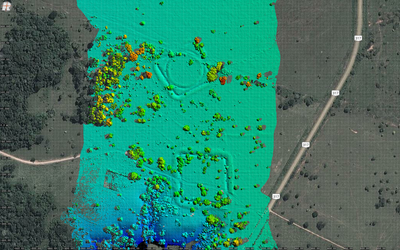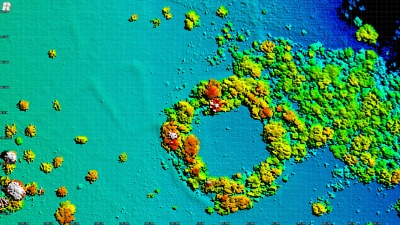|
At the TREES lab, we are testing new technologies for improving our capacity to understand the past, present and future of the Amazon forest.
With a team from National Institute for Space Research, in Brazil and the University of Exeter in the UK we performed the first flights of the fix wing platform named NAURU 500B integrated with a LIDAR (Light Detection and Ranging) system (see images below). These flights were part of the project “Pre-Columbian Amazon-Scale Transformations (PAST)” led by Jose Iriarte from the University of Exeter. For learning more about these Amazonian inhabitants, read the paper from Jonas Souza "Pre-Columbian earth-builders settled along the entire southern rim of the Amazon" published at Nature Communications (https://www.nature.com/articles/s41467-018-03510-7). Jona's paper is the 1st out of 1,067 tracked articles of a similar age in the journal! Now, using these LIDAR point clouds from the UAV and also airplanes, we are investigating the spatial extent of earthworks in Amazonia. We hope to have interesting results soon!
1 Comment
Efforts to preserve tropical biodiversity must go beyond protecting forests with high carbon stocks7/17/2018 A groudbreaking study shows that more carbon means more biodiversity in forests with a high degree of degradation, however, in forests with less human interference, increasing amounts of carbon may not be accompanied by more species.
Tropical forests are rich in carbon as well as biodiversity. As a result of climate and anthropogenic changes in tropical forests, there is an increase in the availability of financial resources for carbon protection in these ecosystems. Protecting carbon from tropical forests is a major goal of international climate change initiatives, drawing tens of billions of dollars in funding each year. However, one question still remains: Are these measures enough to promote the survival of species that inhabit these forests? A study published yesterday in the renowned journal Nature Climate Change (https://www.nature.com/ articles /s41558-018-0225-7) suggests that the answer to this question is not so simple. The study was prepared by an international team of scientists from Brazil, Europe and Australia, including Embrapa Amazônia Oriental (leader of the study) and the National Institute of Space Research (INPE). The group found that investments to avoid carbon losses in tropical forests are likely to be less effective for the conservation of biodiversity in the forests of greater ecological value. To the researcher's surprise, in these forests (which are the most preserved), up to 77% of the species that would have been protected through actions aimed at biodiversity conservation would not be protected in the case of measures focused exclusively on the protection of carbon stocks. "Protecting carbon stocks from tropical forests should remain a central goal in international conservation policies," says Joice Ferreira, one of the leaders of the study and researcher at Embrapa. "This type of measure can not only slow down climate change, but also has the potential to protect life if it is unique and irreplaceable in tropical forests like the Amazon. However, to ensure that such species survive, biodiversity needs to be treated as a central focus of conservation efforts - as well as carbon. " Tropical forests store more than a third of the world's terrestrial carbon. Human-induced phenomena such as deforestation and degradation (logging, hunting, forest fires and forest fragmentation) can trigger the release of carbon and increase the effects of global climate change. Luiz Aragão, a scientist at the Tropical Ecosystems and Environmental Sciences Laboratory (TREES - www.treeslab.org) of INPE's Remote Sensing Division, states that "this study proves the efforts of Brazilian scientists to better understand patterns and processes in tropical forests for supporting public policies for environmental conservation and promotion of sustainable development, such as the National Strategy for REDD + ". Aragão says that "the results of this research are part of a long-term collaboration between these scientists, who have already demonstrated the effects of forest degradation on biodiversity (https://www.nature.com/articles/nature18326 ) and on forest carbon emissions ( https://www.nature.com/articles/s41467-017-02771-y). "We have now been able to connect these two elements, essential for maintaining ecosystem services, carbon and biodiversity, in an analysis that provides support for strategic planning of actions for conservation of our forests", adds the scientist. Remote sensing techniques have already contributed to significant advances in our understanding and quantification of forest carbon, however, Aragão recognizes that "for promoting biodiversity protection there is still a long way to go in terms of development of remote sensing techniques". This development also depends on extensive field monitoring. This study is critical for aligning carbon conservation with biodiversity efforts. Gareth Lennox, one of the study leaders and a scientist at the University of Lancaster, explains that "forests with the highest carbon content do not necessarily harbor more species, which means that conservation focused exclusively on carbon can leave aside rainforest areas that are quite biodiverse". However, the scientist of the Stockholm Environment Institute (SEI, its acronym in English), Sweden, Toby Gardner, one of the co-authors of scientific work, states that "by considering carbon and biodiversity together, we find, for example, that the number of large tree species that can be protected increases up to 15% over the carbon-exclusive approach. In contrast, in this same situation, there is only a 1% reduction of carbon stocks". Reducing the effects of climate change requires the protection of biodiversity. Professor Jos Barlow of the University of Lancaster explains: "Biodiversity and climate change are intrinsically linked when we focus on rainforests. Warmer weather and changes in rainfall patterns will lead to the extinction of many tropical species and it is important to remember that forest carbon resides in the biodiversity of tropical forests. Poverty of species will inevitably result in carbon poverty. Addressing the climate crisis requires the protection of both simultaneously". The scientific article, Ferreira et al. (2018), Carbon-focused conservation may fail to protect the most biodiverse tropical forests (Carbon-focused conservation may fail to protect the most biodiverse tropical forests), is available online in the journal Nature Climate Change ( DOI: 10.1038 / s41558-018-0225-7). |
AuthorLuiz Aragão Archives
July 2019
Categories |




 RSS Feed
RSS Feed
